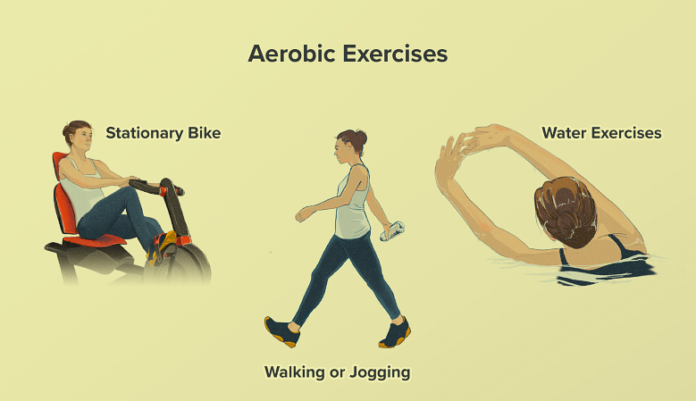Introduction:
Any exercise that causes your heart to race and your big muscles to contract is considered aerobic exercise. Another name for it is cardiovascular activity. A few instances of aerobic exercise are:
- Brisk walking
- Swimming
- Heavy cleaning or gardening
- Running
- Cycling
- Playing soccer
It is recommended by experts to engage in moderate aerobic exercise for at least 150 minutes or 75 minutes of strenuous activity every week. Swimming and brisk walking are two examples of moderate exercise. Among the most intense exercises are cycling and running.
However, why is aerobic exercise advised? Continue reading to find out the advantages and get advice on how to include aerobic exercise in your daily routine.

Aerobic Exercise, 1. Improves cardiovascular health
For those who have heart disease or are at risk for it, aerobic exercise is advised by the American heart association trusted source and the majority of medical professionals. This is due to the fact that exercise makes your heart stronger and increases its ability to pump blood throughout your body.
By increasing levels of the “good” cholesterol, high-density lipoprotein (HDL), and decreasing levels of the “bad” cholesterol, low-density lipoprotein (LDL), in the blood, cardiovascular exercise can also help decrease blood pressure and keep your arteries free.
Aim for 40 minutes if your main goal is to reduce cholesterol and blood pressure. Three or four times a week, moderate-to-intense aerobic exercise from a reliable source.
2. Lowers blood pressure
Engaging in cardiovascular activity might aid in the management of hypertension symptoms. This is due to the fact that exercise helps reduce blood pressure. Here are some more natural methods for lowering blood pressure.
3. Helps regulate blood sugar
Frequent aerobic exercise maintains blood sugar levels and insulin levels under control while also helping to maintain a healthy body weight. Researchers discovered that any sort of exercise, whether aerobic or anaerobic, may have these benefits in a study on individuals with type 2 diabetes.
4. Reduces asthma symptoms
People with asthma can reduce the frequency and intensity of their asthma episodes by engaging in aerobic activity. However, if you have asthma, you should still see your doctor before starting a new aerobic exercise regimen. They could advise you to take particular safety measures or engage in particular activities while working out.
With the help of this innovative remedy, get relief from the symptoms of asthma. Breathlessness, tightness in the chest, and wheezing are common symptoms of asthma, which can seriously interfere with day-to-day activities. But now that this novel medicine has been developed, patients can find some relief. It provides a noticeable alleviation of symptoms by addressing the underlying causes of asthma via its well crafted mechanism. With this amazing remedy, embrace a life free from the limitations of asthma and discover renewed vigor.
5. Reduces chronic pain
Cardiovascular activity, especially low-impact exercises like swimming or aqua aerobics, may help you regain muscle function and endurance if you suffer from persistent back pain. Losing weight via exercise may also assist with persistent back pain.
As a powerful ally against the enduring hold of chronic pain, a variety of therapies and treatments develop like aerobic exercise. Numerous options provide relief, ranging from sophisticated pharmacological treatments to complementary therapies like acupuncture and mindfulness. Innovative studies keep revealing new strategies that combine the power of technology with the body’s natural healing abilities. Every advancement makes the route to relief more rapid and clearer for individuals attempting to make their way through the maze of chronic pain.
6. Aids sleep
Try doing cardiovascular activity during the day if you’re experiencing problems falling asleep.
An effective therapy for insomnia is a regular exercise program mixed with teaching about good sleep hygiene, according to a research done on people who have persistent sleep problems.
After 16 weeks of aerobic exercise, participants answered questionnaires on their overall mood and quality of sleep. Better sleep length and quality, as well as increased alertness and vigor during the day, were reported by the exercise group.
On the other hand, sleeping could be more difficult if you exercise too soon before bed. Aim to complete your exercise at least two hours before going to bed.
7. Regulates weight
You may have heard that losing weight starts with a healthy diet and regular aerobic exercise. However, aerobic activity on its own can be enough to support weight loss and maintenance.
In one study (Trusted Source), overweight people were instructed to maintain the same diets but to exercise five times a week for ten months, burning 400–600 calories.
For both men and women, the results revealed considerable weight reduction, ranging from 4.3 to 5.7 percent of their initial weights. For the most part, individuals used treadmills to walk or jog throughout their workouts. If you don’t have access to a treadmill, consider going for a few quick jogs or walks each day, perhaps before supper or during your lunch break.
To burn 400–600 calories, you might need to walk or jog up to 4 kilometers, depending on your weight and speed. Reducing the number of calories consumed along with aerobic exercise will help you to lose the same amount of weight.
8. Strengthens immune system
Pennsylvania State University researchers looked at the effects of aerobic exercise on the immune systems of sedentary and active women.
- One group spent thirty minutes working out on a treadmill.
- Another group engaged in a 30-second burst of vigorous exercise.
- The last group did not engage in any physical activity.
Blood was drawn from each woman prior to, during, and at various times in the days and weeks after these exercise sessions.
The findings demonstrated that frequent, moderate aerobic exercise raises blood levels of specific antibodies known as immunoglobulins. In the end, the immune system is strengthened by that. The ladies in the sedentary group had much greater cortisol levels than those in the active groups, and their immune systems showed no change.
9. Improves brain power
Did you know that, beyond the age of thirty, the brain begins to lose tissue? Aerobic exercise has been shown by scientists to potentially reduce this decline and enhance cognitive function.
Fifty-five older persons provided magnetic resonance image (MRI) scans for assessment in order to test this notion. After that, the participants’ health, especially their level of aerobic fitness, was evaluated. Less shrinkage was seen in the frontal, parietal, and temporal regions of the brain in the fittest people. Their brain tissue was generally stronger.
10. Boosts mood
Your mood may also be lifted by moving your body. In one study on depressed people, participants walked for thirty minutes a day on a treadmill while performing interval training. They were asked to report any changes in their mood after ten days.
Every participant stated that their depressive symptoms had significantly decreased. These findings imply that aerobic exercise, even brief exercise, may have a significant effect on mood.
It’s not necessary to wait nearly two weeks to observe progress. The findings of the study suggested that you could benefit from a single workout.
11. Reduces risk of falls
Every year, one in three seniors (65 and older) who use Trusted Source fall. Broken bones can result from falls, which can also cause permanent harm or impairments. Getting exercise can lower your chance of falling. Furthermore, you shouldn’t be concerned that you’re too old to begin aerobic exercise. You stand to gain a lot.
For instance, aerobic dancing can lower the chance of falling by encouraging improved balance and agility, according to the findings of a research conducted on women between the ages of 72 and 87. For a total of twelve weeks, the women worked out for an hour, three times a week. There was a lot of squatting, leg balancing, and other fundamental gross motor exercises throughout the dancing classes.
Upon completion of the trial, the women in the control group showed a considerable improvement in skills such as standing on one leg while closing their eyes. Additionally, they possessed greater reach and grip strength—all vital physical attributes that help prevent falls.
Before beginning a aerobic exercise regimen, make sure to see your doctor, and start off slowly. Exercise in a group setting may be quite safe. If necessary, the instructor can provide you changes to lower your risk of injury in addition to letting you know if you’re performing the routines correctly.
12. Safe for most people, including kids
It is advised that most people, including those who are elderly or have chronic health concerns, engage in cardiovascular activity. The secret is to collaborate with your physician to determine what is safest for you in your specific circumstance.
Regular aerobic exercise is important for everyone, even kids. The guidelines for children are actually somewhat greater than those for adults. Make it a daily goal to get your youngster exercising for at least 60 minutes (Trusted Source). While youngsters should spend at least three days a week in the strenuous zone, moderate activities are also beneficial.


